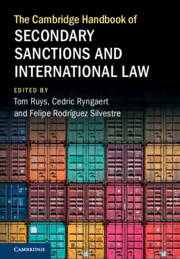Book contents
- The Cambridge Handbook of Secondary Sanctions and International Law
- The Cambridge Handbook of Secondary Sanctions and International Law
- Copyright page
- Contents
- Figures
- Contributors
- 1 Introduction
- Part I Secondary Sanctions
- Part II Secondary Sanctions and General Public International Law
- 6 Secondary Sanctions, Access Restrictions and Customary International Law
- 7 The Correlation Theory
- 8 Challenging Secondary Sanctions in US Courts
- 9 The Application of the Principle of Non-intervention to Secondary Sanctions
- 10 Secondary Sanctions, State Responsibility and Grave Breaches of Jus Cogens Norms
- Part III Secondary Sanctions and International Economic Law
- Part IV Secondary Sanctions in Commercial Practices and Domestic Litigation
- Part V The Future of Secondary Sanctions
- Index
6 - Secondary Sanctions, Access Restrictions and Customary International Law
from Part II - Secondary Sanctions and General Public International Law
Published online by Cambridge University Press: 14 December 2024
- The Cambridge Handbook of Secondary Sanctions and International Law
- The Cambridge Handbook of Secondary Sanctions and International Law
- Copyright page
- Contents
- Figures
- Contributors
- 1 Introduction
- Part I Secondary Sanctions
- Part II Secondary Sanctions and General Public International Law
- 6 Secondary Sanctions, Access Restrictions and Customary International Law
- 7 The Correlation Theory
- 8 Challenging Secondary Sanctions in US Courts
- 9 The Application of the Principle of Non-intervention to Secondary Sanctions
- 10 Secondary Sanctions, State Responsibility and Grave Breaches of Jus Cogens Norms
- Part III Secondary Sanctions and International Economic Law
- Part IV Secondary Sanctions in Commercial Practices and Domestic Litigation
- Part V The Future of Secondary Sanctions
- Index
Summary
Whilst the United States ever more frequently imposes unilateral secondary sanctions, the debate on their lawfulness has only intensified. This chapter focuses specifically on the legality of imposing access restrictions, that is, denying third state sanctions evaders access to the United States and its commercial and financial markets. Until the late 2000s, it was widely held that access restrictions were a means of enforcing US prohibitions. The issue, therefore, was whether the United States had prescriptive jurisdiction to impose such prohibitions. If not, enforcement by way of access restrictions was unlawful. More recently, this has become contested. Some now argue that access restrictions are justified on uncontroversial jurisdictional grounds because they only regulate the behaviour of US persons on US territory. Others argue that access restrictions merely amount to a lawful withdrawal of privileges. In this chapter author’s view, these arguments are not convincing. Based on the relevant US legislation, the chapter shows why access restrictions are indeed enforcement tools. Since the underlying prohibitions cannot be justified under customary international law, such enforcement is unlawful. Furthermore, the international community has consistently condemned US secondary sanctions legislation, including access restrictions, as unlawful, leading to a customary international law prohibition.
Keywords
- Type
- Chapter
- Information
- Publisher: Cambridge University PressPrint publication year: 2024

